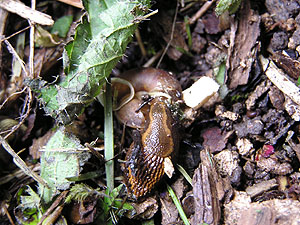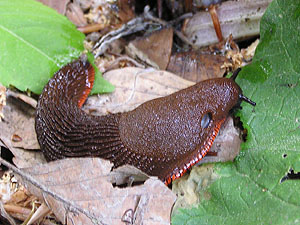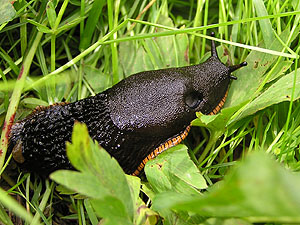
A juvenile Lusitanian slug (Arion vulgaris) feeds on a lapida-
ry snail (Helicigona lapicida).
Pictures: [RN].
 A juvenile Lusitanian slug (Arion vulgaris) feeds on a lapida- ry snail (Helicigona lapicida). |
 Arion rufus or Arion vulgaris? From Wilhelminenberg hill in Vienna (above) and Vogelsberg mountain in Hesse (below). |
|
 |
Slugs, above all the Lusitanian slug (Arion vulgaris), are best known as living lettuce destroyers.
There is a rumour, that Roman snails eat slugs' eggs. Sadly, this is not correct, as Roman snails, like all Helicids, are exclusive herbivores - they only eat plants.
Slugs, on the other hand, are rather variable in their choice of food. So having a closer look, one might be able to see a juvenile Lusitanian slug (Arion vulgaris) feeding on a snail, such as the lapidary snail (Helicigona lapicida) in the picture on the right. Basically, though, Arion slugs are not predators.
It is more probable, that the snail was killed by some other animal, such as a beetle, the slug afterwards taking advantage. A hint in that direction is that the slug eats the snail though a hole in the shell, which it would not have been able to make on its own.
Externally it is sometimes very difficult to tell apart the different species of large Arion slug species. A black Arion with a red foot seam (lower left picture) is most probably an Arion rufus. A brown one on the other hand (upper left picture) could quite probably also be an Arion vulgaris. Only the young of Arion vulgaris, though, are easily recognised by their characteristic pattern of colourful stripes (right picture).
Arion slugs, though, are not the only omnivorous slugs - especially the large keelback slugs (Limacidae), such as the leopard slug (Limax maximus) eat other snails and worms as well as plant matter or mushrooms.
To be continued...